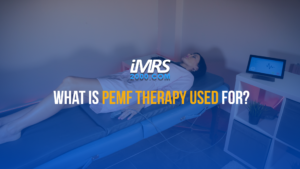PEMF for Alzheimer’s: What Medical Practitioners Need to Know

A growing body of medical research has demonstrated that pulsed electromagnetic field therapy (PEMF) may have a beneficial effect on patients with Alzheimer’s disease.
Studies have found that PEMF may improve brain activity and cognitive function in Alzheimer’s patients, leading researchers to conclude that the therapy may “open new avenues in the management of memory disturbances in the elderly.”
In this post, we outline how PEMF works and what medical practitioners need to know about the current research on using pulsed magnetic field therapy for Alzheimer’s.
What is PEMF Therapy?
PEMF therapy is a therapeutic modality that is increasingly used by medical practitioners to supplement (or replace) traditional treatment options for pain, inflammation, mood disorders, sleep disorders and a wide array of other ailments.
PEMF uses pulsating low-level magnetic energy, typically delivered via a cushioned mat or peripheral devices, which stimulate cellular activity in the body. In turn, this can help to improve cellular function and support the body’s natural healing systems. Dr. Christopher Williams of the Interventional Orthopedics of Atlanta explains, “Any disruption in electrical currents [in the body’s cells] can lead to dysfunction or illness. PEMF therapy helps restore this disruption in electrical current to the normal state, which promotes overall wellness.”
The Role of PEMF Therapy for Alzheimer’s

While there is currently no cure for Alzheimer’s, some treatment programs help to temporarily improve or slow the progression of symptoms. However, options such as medication often fall short in improving cognitive function and are instead used principally to control behavioral symptoms of the disease.
PEMF therapy may help to fill this gap as an effective modality for improving cognitive and memory function by stimulating cellular activity in the brain.
What the Research Says
- A 2016 review by Dr. Gary D. Arendash, published in the Journal of Alzheimer’s Disease, writes, “We have demonstrated in multiple studies that daily, long-term electromagnetic field (EMF) treatment in the ultrahigh frequency range not only protects Alzheimer’s disease (AD) transgenic mice from cognitive impairment, but also reverses such impairment in aged AD mice.” The paper concludes: “Based on a diversity of pre-clinical studies from our laboratory in collaboration with others, the neuromodulatory approach of [electromagnetic field therapy] appears to offer unique, disease-modifying potential that could limit or reverse AD memory loss.”

- A 2022 clinical trial further supported Arendash’s research by monitoring the cognitive performance of eight Alzheimer’s patients who received daily in-home electromagnetic treatment for a period of 2.5 years. The therapy appeared to stop the cognitive decline in these patients, as the paper concludes: “Results suggest that [electromagnetic therapy] can stop the cognitive decline of AD over a period of at least 2.5 years and can do so with no safety issues.”
- Results from a 2017 study demonstrated that “LF-PEMF can stimulate an epigenetic regulation mediated by miRNAs, which would lead to a rebalancing of the pathways’ deregulation occurring in [Alzheimer’s disease].” The results suggest that “the electromagnetic fields at low frequencies, if properly used, may be useful for the treatment of patients with AD, as suggested by the results of pilot experiments with deep brain stimulation via EMFs.”
PEMF as Supplementation
Several studies have shown that PEMF can be especially effective when used in conjunction with patients’ other treatments, such as prescription medication or physical therapy. Additionally, as a non-drug option, it may be preferred by patients and physicians who want to avoid the risks of dependency or other side effects of medication.
A 2020 medical review in Biomedicine & Pharmacotherapy wrote that “Increasing evidence suggests that this noninvasive, safe and effective therapy might be a promising adjuvant for treating various musculoskeletal disorders.” Researchers concluded that “Considerable studies have explored the underlying cellular and subcellular mechanisms of PEMF stimulation on various musculoskeletal diseases, providing a molecular basis for extending its clinical application.”
In a separate systematic review from 2020, researchers noted the growing body of evidence that “electromagnetic field therapy relieves pain and improves function in patients with various pain musculoskeletal diseases. Electromagnetic field therapy is well tolerated with no reported negative side effects in the analyzed studies. [Thus], it could be a helpful component during drug therapy for chronic and acute pain in musculoskeletal disease.”
Learn more
To learn more about using PEMF to supplement other treatment options at your medical practice, contact iMRS 2000. We offer the leading PEMF devices on the market and can guide you to the right solution for your needs.




